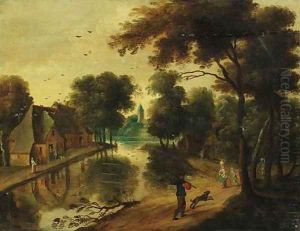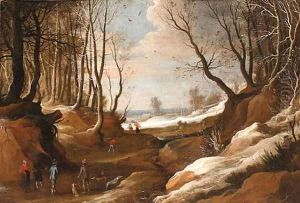Jacques Foucquieres Paintings
Jacques Fouquières, also known as Jacques Foucquieres or Jacques Fouquières, was a Flemish Baroque painter, who specialized in landscape paintings. He was born in Antwerp in 1580 into a family that was part of the city's artistic community; however, not much is known about his early life and training. His work reflects the transition in European art from the late Renaissance to the Baroque period, and he was one of the prominent landscape artists of his time.
Fouquières' career began to flourish after he moved to Paris in the early 17th century. He found favor at the French court and was appointed as a painter to King Louis XIII. In France, he became known for his wooded landscapes, often depicting scenes with figures and animals within natural settings, which were influenced by the earlier Flemish tradition of Pieter Bruegel the Elder and the Mannerist world landscapes.
His landscapes are characterized by a high degree of detail and a keen observation of nature, with a strong sense of atmospheric perspective. They often include historical or mythological figures, imbuing the scenes with a narrative quality. Despite the classical themes, Fouquières' work is noted for its realistic depiction of the natural environment, featuring accurate representations of the flora and fauna of his time.
Jacques Fouquières' work was not only appreciated in France but also attracted international attention. He influenced a number of other landscape painters, both during his lifetime and posthumously. Unfortunately, due to the scarcity of biographical information, many of his works are poorly documented or attributed, which has affected the study and appreciation of his contribution to the art of landscape painting.
He passed away in Paris in 1659, leaving behind a legacy as one of the key figures in the development of 17th-century European landscape painting. His work continued to be appreciated and collected by art connoisseurs and played a role in shaping the French landscape tradition that would come to full fruition in the works of artists such as Claude Lorrain and Nicolas Poussin.

